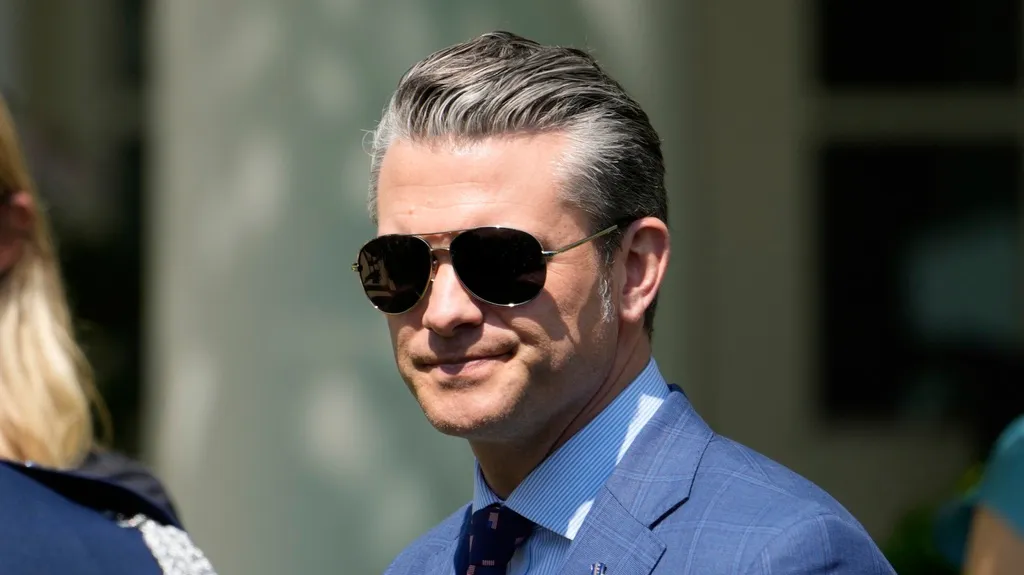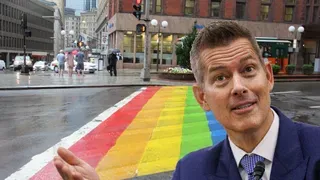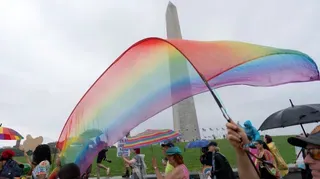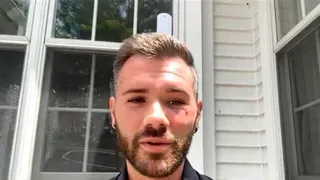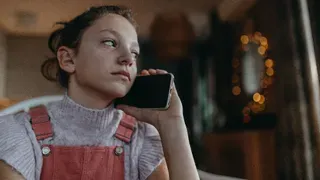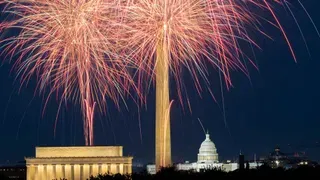September 23, 2011
Biker ethos kick-started Folsom scene
Kevin Mark Kline READ TIME: 10 MIN.
Around the beginning of September when the black and blue flags go up, everyone knows it's that special time of year again: two months of sunlight and a whole lot of leather.
On September 25 Folsom Street between 7th and 12th streets will be cordoned off for the Folsom Street Fair, as it has been for 27 years now, since "Megahood" started it all in 1984.
Many of Folsom's attendees simply enjoy the fair for what it is today, without pondering its evolution through the years, or the South of Market neighborhood conditions that led to its creation.
The gay male leather culture that hangs on today in SOMA and peaked in the pre-AIDS era has its roots in motorcycle clubs and marooned sailors and waterfront bars of the 1950s like Castaways and the Sea Cow. The first leather bars popped up in the Tenderloin, and were usually short-lived and subject to police harassment: The Spur Club, Why Not, and The Hideaway were all raided and closed between 1959-62.
Author, anthropologist and leather historian Gayle Rubin, in her essential 1998 essay "The Miracle Mile," traces the roots of today's gay male leather culture back to sailors and bikers: queer men who confounded the prevailing notion of homosexuals as effeminate and easily identified sissies.
"If gay male leather can be said to have a core meaning, it would have to be masculinity," Rubin wrote, adding that the motorcycle, more than anything else, symbolized that masculinity.
"Homomasculinity" was the word coined by Drummer magazine editor and pop-culture polymath Jack Fritscher to describe the gender expression of masculine-identified leathermen.
Gay motorcycle clubs started with the Satyrs in L.A. in 1954. The Warlocks and the California Motorcycle Club, both San Francisco-based, soon followed. The first CMC Carnival in 1966 marked the inception of a social institution for the emerging leather scene, continuing to the birth of the Folsom Street Fair.
"Leather culture was constructed on a discreet circuit of bike runs, bars, back rooms, and the annual autumn orgy of the CMC Carnival," wrote Fritscher in his essay on the first Folsom, "Leather's Burning Man."
Rubin identified the opening of the Tool Box on Harrison Street in 1962 as the catalyzing agent of the leather scene "South of the Slot," as SOMA was called in the old days.
Tool Box featured Chuck Arnett's legendary mural epitomizing the homomasculine ideal of the gay leather set and garnered national attention, including an infamous Life magazine spread in 1964 that crowned San Francisco the nation's "gay capital."
The Life expos� largely conflated "homosexual" with "criminal pervert," but made some astute observations, including the objection of "homophile groups," like the Mattachine Society and the Council on Religion and the Homosexual, to the military's practice of dishonorably discharging known queers from its ranks. (In case you thought the now repealed "Don't Ask, Don't Tell" started with Clinton.)
A police raid on a dance at California Hall on New Year's Eve in 1965 has since been branded "San Francisco's Stonewall" for the way it galvanized not only the nascent gay rights groups but also mainstream public sentiment through media coverage and the judicial system against police prejudice and abuse of power.
Fair nights in the valley
So began the feast of the kings, a latter-day Bacchanalian orgy when, in the words of San Francisco recording artist Donald Currie, "Gays took over, and we turned the city into a bathhouse."
Febe's opened on Folsom Street in 1966 and long reigned as the leading gay biker bar. Mike Caffee's iconic "Leather David" served as the bar's logo. One elegist in the 1996 treasure trove Gay by the Bay recalled Sunday afternoons at Febe's as "a massive grope-a-torium where anything happened."
The Stud, eldest surviving statesman of the scene today, opened the same year as Febe's. It started as a leather bar with a Hells Angels crowd but had morphed into a hippie haven by the time of Woodstock, complete with dance floor and psychedelic blacklight mural.
All through the 1960s and on into the superlative 1970s new bastions of the leather kingdom sprang up: Bathhouses and sex clubs (The Barracks, The Plunge, The Sutro Baths, The Catacombs), shops and galleries (A Taste of Leather, upstairs at Febe's; a leather shopping mall called Big Town; Fey-Way Studio, the first gay art gallery), groups and events (The Warlocks' "Witches Christmas," CMC Carnival, the Satyrs' annual Badger Flat Run).
And a plethora of bars joined the scene. To name just a few: Off the Levee, Ramrod, the No Name Bar (known by many names over the years, presently Powerhouse), the Trocadero (where Sylvester performed), the Bay Brick Inn (a lesbian pleasure palace), Folsom Prison, the Black and Blue, the Red Star Saloon.
A spreadsheet maintained by the GLBT Historical Society lists 211 different names of gay bars, bathhouses, and related businesses in SOMA, past and present, though some are multiple names for the same location.
The SOMA scene, in particular the bars grouped on and around Folsom Street in the vicinity of the present-day street fair, also acquired nicknames, sociological markers of a legend-in-the-making: The Miracle Mile, Valley of the Kings.
The former name was bestowed by the late San Francisco Chronicle columnist Herb Caen, the latter by "Mr. Marcus" Hernandez, first Emperor of San Francisco and longtime B.A.R. leather columnist before his death in 2009.
"Valley of Kings conveyed an image of powerful, cocky, independent, and sexy masculinity," Rubin expounded. "It contrasted with Marcus' nickname for Polk Street, 'The Valley of the Queens,' in reference to the older and sometimes more effeminate population of gay men associated with the area."
The Castro was "The Valley of the Dolls," in reference to its "hordes of young and beautiful men" (in Rubin's words) as well as its pharmaceutical drug culture, "dolls" being old-school slang for pills.
Circa 1971 the bandana or "hanky" code entered currency as a discrete way for leathermen to communicate their orientation and kinks. The first International Mr. Leather conference was held in Chicago in 1979, spinning off locally the Mr. San Francisco Leather Competition, as well as the Mr. Drummer Contest sponsored by Drummer magazine.
Mr. Drummer led to the inception of San Francisco Leather Pride Week, as Rubin discussed in her heartfelt essay "Elegy for the Valley of the Kings."
Miracle on Folsom Street
At the same time that the Miracle Mile was coming into its own, an antithetic current was flowing through the neighborhood, a trend of "slum clearance and urban renewal."
Folsom Street Fair co-founder Kathleen Connell, together with LGBT historian Paul Gabriel, penned an in-depth history, "The Power of Broken Hearts" available at http://folsomstreetfair.org/history, that documented the SOMA anti-gentrification movement.
Connell and Gabriel chronicled how neighborhood activists organized against ruthless developers and government agents that regarded the neighborhood as an example of "urban blight" and traced the way that movement led to the genesis of the Folsom Street Fair.
In 1980, while working for the South of Market Alliance, a neighborhood advocacy group, Connell met and befriended fellow gay activist Michael Valerio, who was also the assistant director for Tenants and Owners Development Corporation.
Valerio and Connell found common ground in their support for low-income families, artists, senior citizens and the gays in SOMA, and in their desire to incorporate their "gay selves" into their work.
The neighborhood was threatened by the encroachment of high-rise development, and the gay men's community was under attack by a new plague first identified in 1981: AIDS. Connell and Valerio decided to launch a SOMA fair as the best resistance against the powers that would destroy (or displace) them.
"In addition to community preservation, we were making a big statement about the AIDS crisis, and trying to raise funds as there were no social services to speak of at that time," Connell told the B.A.R.
From their efforts came "Megahood," the first Folsom Street Fair, in 1984. "South of Market Sizzles in September" promised a headline in the June/July 1984 edition of the South of Market News, a neighborhood paper whose hype helped insure a good turnout.
In the beginning Folsom was not explicitly a sex or leather event, but the gay leather scene was a significant presence from the start. Drummer endorsed the first fair, albeit with some misgivings.
"Leatherfolk anxiety ran deep in Orwellian 1984, rightly suspicious of event producers purposing leather for fundraising parallax to the way Harvey Milk started the Castro Street Fair to sign up voters," Drummer editor-in-chief Fritscher recalled.
Up Your Alley Street Fair, which started in 1985 on Ringold Street, was a dedicated gay leather event from the beginning. Ringold is an alley south of Folsom between 8th and 9th onto which a number of the leather bars exited. It wasn't the fair's home for very long.
Connell's history recalled, "Ringold is a residential alley, and the neighbors, while tolerating dead-in-the-night activity, did not take kindly to this sudden explosion of leather and fetish men and women on their street. They successfully petitioned the city and the SFPD to rescind the granting of a license for a third year."
If the move seemed a setback at first, the fair survived and then some. Around 12,000 people - mostly gay leathermen - attend Dore Alley, as locals now know it, the last Sunday in July.
Panic at the bathhouse
The Folsom Street Fair sizzled, but the SOMA leather scene fizzled. It was AIDS, of course, that killed the party. The "Gay Cancer" triggered a wave of homophobic panic and revulsion directed at leathermen in particular. Feast abruptly turned to famine.
The Castro survived to become the international attraction it is today, but the Folsom scene fell into permanent disrepair. The Castro's core was politics, which were fanned to a blaze by the AIDS crisis; but the core of Folsom was sex, and sex lost its infrastructure when the bathhouses closed.
Bars closed, too. Tool Box had been torn down in 1971, a victim of redevelopment. A large fire in 1981, starting at the former Barracks, destroyed many homes and a number of key establishments. By the mid-80s, as the effects of AIDS intensified, leather bars began dropping like dominoes.
When Febe's closed in June 1986, "Even the TV news covered it," as recollected in Geoff Mains' 1989 novel-elegy Gentle Warriors, which provides a poignant look back at the Miracle Mile's heyday in the form of a "last motorcycle ride" through the ailing bar district.
Partly due to the toll of AIDS, the producers of Up Your Alley merged with those of the Folsom Street Fair in 1990, and it was around this time that the official posters and promotional images for Folsom became overtly "leather-ized," as they had not been previously.
One of the many casualties of AIDS was Michael Valerio. He had gone on to form other community organizations and win various awards before succumbing to the disease at the age of 40. The B.A.R. printed his obituary in 1995.
The bathhouses remain closed today: the legacy of public policy-makers swayed by hysteria and a virus we've learned to manage but not eradicate. A prowling sex fiend must cross the Bay Bridge and head to Steamworks in Berkeley for a club with private rooms. It seems the state of affairs of the mid-80s persists in the mainstream LGBT community to this day, a watershed shift away from open and unbridled sexuality.
What does this mean for a demographic whose defining trait is sexual orientation?
"I understand the panic back in the day, but now most sex clubs don't have proper cleaning facilities - aside from bathroom sinks," said B.A.R. leather columnist Scott Brogan. "I think that's much less healthy than having a private room with a bath that you can wash up in - or the public showers at the baths."
Queer scholar Greg Jones, 36, who has written on bondage and sadomasochism in ancient Greece, recalled, "When I first moved to the city in 1998 people were still smoking pot and giving each other blowjobs in the back of the old Hole in the Wall. But the last time I tried to get frisky there the bartender came round and scolded us.
"Now there are signs in bars, literally posted every 5 feet - especially during Folsom Weekend - that yell 'No sexual activity!'" added Jones.
(Wicked Grounds Cafe now occupies the space of the original Hole in the Wall, which has moved a couple blocks away to 1369 Folsom St.)
Former Lone Star Saloon manager Steve Hoffman, 46, said proprietors are caught between patrons who want Folsom to live up to its lascivious past and health and law enforcement officials reacting against that same reputation.
"I can see the customer's point of view, but I definitely understand the owner's perspective too, because if you let people have sex in the back room and get busted, you lose your liquor license," Hoffman explained.
Just such an incident caused the closure of My Place, formerly the Ramrod (1225 Folsom St.) The space re-opened as Chaps II in 2008. (The original Chaps was located where the DNA Lounge is now.)
No one would suggest that sex itself is seriously endangered. But what about the leather community?
"It's obvious the leather scene isn't as strong as it used to be," said Hole in the Wall bartender Miguel Chavez. "And bars can't survive if they cater to people who only go out once a month."
That explains the re-branding of Chaps II as Kok in spring 2011. Lone Star changed management and most of its staff in 2010, alienating some. (Hoffman hasn't been there since the change.) Most recently, the Eagle Tavern closed last April after nearly 30 years, ending a long tradition of Sunday afternoon beer busts that drew a diverse crowd including fetishists of all flavors. [See story Page 1.]
(El Rio now hosts a beer bust called "The Eagle in Exile" on the first Sunday of every month - 3158 Mission St. at Precita.)
Hoffman said that "leather" today has broadened into a catch-all term for kink in general, encompassing a profusion of fetishes - bears, military gear, sportswear, golden showers, exhibitionism, varieties of bondage and discipline. Furries, anyone?
The Leathermen's Discussion Group, which meets the 4th Wednesday of every month above Blow Buddies (933 Harrison St.), held a panel discussion in July with historian Rubin as a panelist that asked, "Is Leather Dead?"
"The leather community has become more privatized, and its ability to occupy public space in the Folsom has become more limited and occasional," Rubin wrote on the subject. "However, the Folsom is still a magnet, a piece of sacred ground, and a powerful symbol."
Brogan attended the July discussion and described it and Rubin as "a blast."
"The hanky code and leather uniforms in the old days were ways of letting people know what you were into," Brogan added. "It's true that things are much more open and accessible these days. Some might say too much so, but I believe things evolve naturally and there isn't anything to do about it except to enjoy the ride."
